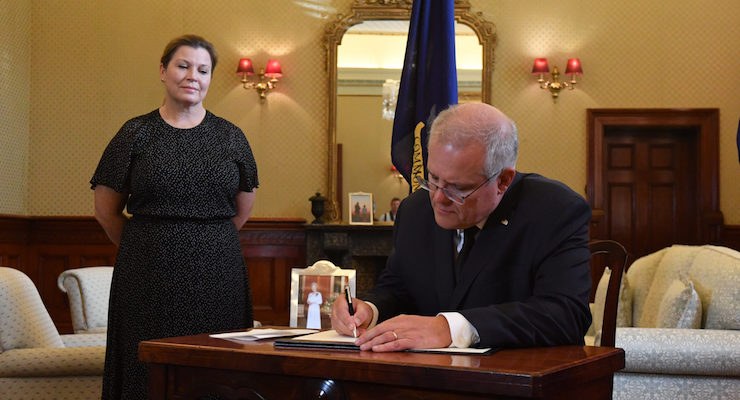
“Why would you put something that looks like The Handmaid’s Tale out as a photo op?” actor Magda Szubanski asked this week.
She was criticising a staged photo featuring Prime Minister Scott Morrison signing a condolence letter to the royals following the death of Prince Philip. In it, his wife Jenny stands behind him dressed all in black, her dark hair slicked back and her hands clasped behind her. A photo of the Queen is thematically turned towards the camera.
The timing and optics of the picture are questionable given Morrison’s drastically waning popularity among women. Women have been abandoning support for the Coalition in droves following his handling of parliamentary sexual assault allegations.
But among men, Morrison’s popularity has hardly budged. He and his media adviser’s blindness to the optics of such a picture raises a chilling proposition. Is Morrison’s team completely ignorant to how these sort of photo ops can be perceived by women? Or is it deliberately stoking anti-feminist sentiment it believes is rife among key demographics, leavening arguments between the left and the right crucial to distract from other ongoing issues?
‘Don’t let the bastards grind you down’
Szubanski’s criticism, initially made on Twitter then defended on A Current Affair last night, blew up. Liberal MP Nicolle Flint called the comment “nasty” and “appalling”. The Herald Sun‘s Rita Panahi accused the left of double standards and “misogynistic vitriol” in criticising Jenny’s appearance.
Szubanski maintains she never mentioned Jenny’s appearance, saying she wanted to highlight the growing influence of “far-right Christians” in political life and to know “what kind of woman” Jenny is (which Crikey has covered).
The influence of religion on Australian politics is a concern that should be addressed. Morrison, as Crikey revealed yesterday, wrote his university thesis on the Christian Brethren church. He and his wife met at a Christian camp, moving from Brethren to Baptist to Pentecostal — groups that have a literal reading of the scriptures and deep concern for conservative values, including gender roles.
Morrison’s siloing away of “women’s issues” as a matter to be dealt with by women is a legitimate concern; as is his appointment of Assistant Minister for Women Amanda Stoker, who has glowing references from men’s rights groups thanks to her association with men’s rights activist Bettina Arndt.
Yet the conversation has shifted away from the creep of Christianity into Australian politics and Morrison’s treatment of women to instead focus on Szubanski’s so-called “hypocrisy”.
Praise be!
Unsurprisingly, women don’t like this constant barrage of sexism and inaction to sexual violence from the Morrison government. This week’s Essential Media poll showed Morrison’s approval from female voters is in freefall, dropping from 65% to 46% since Brittany Higgins’ allegations were made public in February. The Coalition is losing ground in WA, Queensland and South Australia.
But the male vote tells a different story. Support for Morrison among men has largely remained unchanged, dropping only slightly from 65% to 61% during the same period. In a few demographics, support for the PM is up by double digits.
Approval for the PM increased among men aged 18-34 between January and March, from 56% to 67%. Support also rose amongst men in rural areas, from 59% to 70%. And men on lower incomes are also more favourable of the PM.
This polling, however, comes with a number of caveats. The sample size is small and contradicts a recent analysis of Newspoll data, which suggests the Coalition has suffered a flight of male voters over the last three months.
A message to men
Joshua Roose, a senior research fellow at Deakin University’s Alfred Deakin Research Institute for Citizenship and Globalisation, told Crikey Morrison had been consciously sending a message to men who believed feminism has gone too far, and the data showed that it was being heard loud and clear.
“Every time he puts on his hat and goes into the Cronulla Sharks change room and shakes hands with the players, he’s attempting to mobilise this sense of working-class masculinity. It’s an element of his strategy. He’s not necessarily supporting anti-women hate groups, but he refuses to budge on things like sacking Laming,” he said.
Roose pointed to a 2019 Ipsos poll that showed 40% of Australian men believed that, when it comes to giving women equal rights, things had gone “far enough”. This, he said, showed there was still deep-seated anti-women attitudes in the community.
“The vast majority of men in this country continue to see women’s rights through the spectrum of having daughters or sisters or mums. So when Morrison came out and spoke about Jenny, that was tapping into that idea.”
While Morrison may not be going out of his way to tap into the men’s rights cohort, he certainly seems to benefit from keeping some of them as part of his constituency.









Szubanski’s observation would reflect the thoughts of most Australian women familiar with Atwood’s book. The comment wasn’t ‘nasty’, it was merely stating the obvious.
Quite correct.
Correct. I am deeply concerned by the presence of QANON in the Lodge & Jen’s little hand signals. This needs to be properly explained. The silence is telling. If you asked Australians in the 1980s if they could ever see a time when christian conservative prosperity snake oil salesmen were in charge of the country, very few would have said yes. Yet here we are.
Looking at the posed photo of Morrison and his wife I can only say “what were they thinking” (or drinking, or smoking). It conjures up the old testament, the Handmaids Tale, and just about every other repulsive image in my (probably limited) imagination.
It is admittedly a poor visual, admittedly done very deliberately.
The image certainly fits very well with Katherine Murphy’s recent suggestion in The Guardian that Morrison deliberately concentrates all his PR quite narrowly on “men at risk of voting Labor”. And it seems to be working.
He is a politician so i dont think he cares which gender votes for him. A vote is a vote.
But his political strategists may have done the numbers and determined he stands to gain the most from such a tactic.
“And **it** seems to be working”
I dont think we can make a clear case for cause and effect there. Just because men havent abandoned him doesnt prove his PR is working. Men largely see the situations (AG, Brittany, Holgate etc) as having different drivers than just gender. Reading thru the comments around here and women clearly think gender is the primary explanation.
“He is a politician so i dont think he cares which gender votes for him. A vote is a vote”
That’s how most politicians would see it for obvious reasons. But, as Murphy points out with abundant evidence over his entire time as PM, Morrison acts as though either he’s unaware that women these days can vote, or else he believes they all dutifully vote as their husbands tell them. If you were right he would not be doing this.
Growing up Brethren he no doubt has a certain view on the place of women. For the record I’m no fan of M or any of the names you mentioned.
It was a good article until Joshua Roose was quoted with his idiotic leap of logic on what the statistics implied. It was deliberately added as a (ham fisted) attempt to associate M’s behaviour and that of Australian males in general. It reflects badly on her and yet again shows she is writing as an activist not a journalist.
Putting aside whether men do or dont have “deep-seated anti-women attitudes”, do you feel THIS particular statistic (40% of men saying equality has gone far enough) proves it?
Refer to my post above linking to Australia’s ranking of 26th out of 178 for gender equality according the the UN.
Hi Sinking Ship Rat, could you please respond to my question?
“Hi Sinking Ship Rat, could you please respond to my question?”
Who on earth do you think you are?
And why would you think my opinion (or indeed yours) on the statistic has any bearing on whether Crikey should publish Roose responding to the poll findings?
Desmond Graham disputed the interpretation of the static and you replied “That’s not what the article says”, so Im asking what do YOU think it means then. Seems a reasonable thing to ask you.
I certainly think that this article, the topic and the treatment are nothing but ‘static‘.
I don’t even know what ‘40% of men saying equality has gone far enough’ means. And, if it were so, I would hear this type of language from men all of the time. Not in my experience.
I can only imagine that the question was completely loaded to get a result like that.
Push polling is real and pernicious but not new.
This piece is little more than a euphemism for “me mates at the pub” gutter reportage .
Its such a creepy photo. It says everything we need to know about Morrison & his depressed silent sidekick.
Is Morrisons wife`s live-in friend actually some type of carer, are there physiological issues involved, looking at the photo that’s not an illogical question to be asking, and voters are perfectly entitled to ask it as they are paying that cost and the P.M seems to often rely on her advice so is that advice based on rational grounds.
Good question. The ‘minder’ is the partner of Australia’s most well known QANON follower. QANON has a place in The Lodge along with the Pentecostal lunacy. The photo is worth a thousand words. It will win Morrison the votes of all the men who are frightened of us women who have escaped from our minders & the kitchen & are not afraid to talk out. This photo says “I have MY little woman under control”. Sad that many Australian men will like this.
Would you say “us who escaped..”?
Sadly, you and many probably would.
“..men who are frightened of
uswe women…”. TFIFYAny religion which boils down to “money will earn you praise” should be cause for alarm.
The treatment by these so called ‘Christians’ of people on the NDIS, asylum seekers and the robodebt class action…is that what Jesus would want?
Very warped to claim to be a ‘good Christian’ and then kick people in the head when they’re down. It’s hard to believe that we paid for these people to get empathy training.
I guess there’s other motivations involved for acting so cruelly, notably power and money.
That Ministers like Stuart “Rort King” Robert have been sacked before, but since promoted (twice) by his Church pal Scott, par for the course.
‘Stuey’s’ wife is a minister in said church of the same flock. When ‘Stuey’ was charging us ~$4k per month for home Internet, guess who was delivering sermons online…
I have often wondered how and why ScoMo thinks he is a Christian. Must be using only a ‘selection’ from the Ten Commandments.
The posed photograph made me laugh out loud. How could such a close representation of Aunt Lydia have been allowed past the eagle eyes of the minders and spin doctors. The frantic struggles of this bunch of whackos to appear organised and intelligent has become risible.
Ew. Hadn’t looked at Jen as Aunt Lydia but now that you mention it, its all I can see!!
But SmoKo is no Commander.
I admit I haven’t changed my opinion of Morrison during all his gaffes and fumbles. Despised him before, despise him now. He is out of his depth. He should pack his bags and go back to Cronulla and take his whole talentless team with him.
I’ve despised him since it was revealed how he crawled into the parliament. Since then I have regarded him as a fake.
So how did he crawl into parliament? (I’ll read a good link if you’ve got one.) As for what kind of a person he is, I’ve despised him since the ‘stop the boats’ thing and waving a lump of coal in parliament — literally mocking the distress lots of people feel for the future of our society
Are you unaware that in preselection he got 8 and Towke got 83. Suddenly there were reports going round about Towke by mates of Slymo, Towke was dropped, Slymo got the seat and that’s how he’s worked his way up ever since. Pity someone doesn’t come clean about why he, Slymo, was sacked from two tourism jobs.
Daibhin, thanks for that.
Yes, I just looked up who Michael Towke is. Particularly interesting that News Corp. went out on a limb to help with the cause.
Apart from what happened in the pre-selection contest in Cook argy-bargies seem to have popped up wherever Scott Morrison has been. Pretty clear he is the cause of these things.
But of course these tactics can only get you so far in life. As prime minister he’s supposed to have values and a concept of what he thinks the country needs. He has neither and so the country doesn’t really have a prime minister, just that guy, who loves the power and the trappings and nothing important gets done.
Now we’re talking. Best post today.